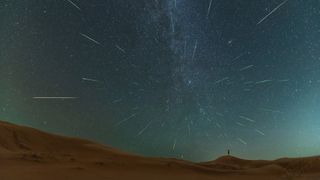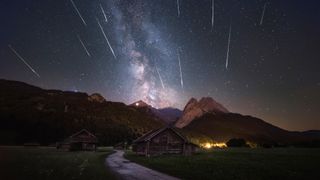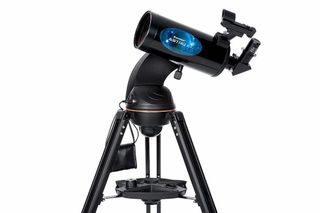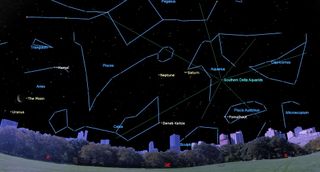
Anyone gazing at the summer night sky for even a short length of time is likely to spot a few "shooting stars" darting across the sky.
The best meteor display of the summer comes during the second week of August during the annual Perseid meteor shower which, at its peak around the nights of Aug. 11 and 12, is capable of producing 50 to 100 fast, bright meteors per hour for a single observer. Many flaring meteors with trains are seen under good skies. 2024 will be a very good year to watch for the Perseids, because bright moonlight will not interfere.
The very first forerunners of the Perseid shower began to appear around July 25. You'll only see a few per hour at best, but the numbers will begin to ramp-up during the second week of August. The last Perseid stragglers may still be noted as late as Aug. 18.
In general, the Earth encounters richer meteoric activity during the second half of the year. And you're more likely to see twice as many meteors per hour in the predawn hours as compared to the evening hours. This is due to the fact that during the pre-midnight hours we are on the "trailing" side of Earth, due to our orbital motion through space.
So, any meteoric particle generally must have an orbital velocity greater than that of the Earth to "catch" us. However, after midnight when we are turned onto the Earth's "leading" side, any particle that lies along the planet's orbital path will enter Earth's atmosphere as a meteor. As such objects collide with our atmosphere at speeds of 7 to 45 miles (11 to 72 km) per second, their energy of motion rapidly dissipates in the form of heat, light, and ionization, creating short-lived streaks of light popularly referred to as "shooting stars."
If you want more advice on how to photograph the summer meteor showers, check out our how to photograph meteors and meteor showers guide and if you need imaging gear, consider our best cameras for astrophotography and best lenses for astrophotography.
Get the Space.com Newsletter
Breaking space news, the latest updates on rocket launches, skywatching events and more!
Meteor supernumeraries
To go along with the Perseids, however, there are many other minor meteor displays that are active at various times during July and August. While the hourly rates from these other meteor streams are but a fraction of the numbers produced by the Perseids, combined, they provide a wide variety of meteors of differing colors, speeds and trajectories. Summertime meteors, occasionally flitting across your line of sight, are especially noticeable between late-July and the third week of August.
And between July 26 and Aug. 21, there are no fewer than six different minor displays that are active. Among these are the Capricornids, Delta Aquarids, Piscis Australids, Alpha Capricornids, Iota Aquarids and Kappa Cygnids.
The radiant points for five of these showers peak highest, about halfway up in the southern part of the sky between 1 and 3:30 a.m. local daylight time. A radiant is the place in the sky where the paths of shower members, if extended backward, would intersect near the star or constellation for which the shower is named. Many people are misled into thinking that this is the best place to look for these meteors, but actually the greatest numbers will be seen in the region of the sky overhead and toward the south.
In addition to shower meteors, there are always sporadic ones, apparently unrelated to one another, that occur at an average rate of about seven an hour. The duration in days of a shower is somewhat arbitrary, since the beginning and ending are gradual and indefinite.
The only equipment you'll need is your eyes and a modest amount of patience.
As one long-time meteor enthusiast once noted: "Meteor observing is relaxing and enjoyable, potentially dramatic and just plain fun!"

The minor shower list
This first of our showers is the Capricornids, which peak on July 26, though extending from July 10 to Aug. 15. The radiant reaches its highest point in the south at about 1:45 a.m. At most, only a few bright Capricornids will appear per hour, but this year these meteors will be handicapped by a bright gibbous moon brightly shining in the east-southeast sky.
Only two days will elapse until the Piscis Australids come to a maximum on July 28 (July 15 - Aug. 30). The radiant crosses the meridian at 3:30 a.m. This is a lesser stream; only about eight members per hour will be visible to observers primarily in the Southern Hemisphere, where the radiant climbs high in the sky. But the light from a nearby last quarter moon will hinder visibility.
Also, on July 28 comes the peak of the Delta Aquarids, (July 12 - Aug. 23). This shower has two radiants, indicating that we are seeing two distinct streams of celestial debris which produce faint, medium speed meteors burning up in the Earth's atmosphere. As many as two or three dozen meteors per hour are produced by this shower and the radiants peak highest in the south at about 3 a.m. But the same last quarter moon that will interfere with the Piscis Australids, will also likely reduce the number of Delta Aquarids that may be seen.
Another weak shower is the Alpha Capricornids, which begin about July 3, peak on July 31, and end on Aug. 15. The radiant is highest in the south around 1 a.m. Though few in number, the Alpha Capricornids frequently produce slow, bright — at times, fireball class — long trailed yellow meteors that can be quite spectacular. Good news: the moon has now diminished to a thin crescent and will provide little, if any inference in looking for these meteors.

Looking for a telescope for the next night sky event? We recommend the Celestron Astro Fi 102 as the top pick in our best beginner's telescope guide.
The last minor shower before the Perseids is the Iota Aquarids, another two-radiant shower having detectable numbers from July 15 to Aug. 25. Peak activity is August 6th with only about six members per hour are seen under good conditions; the radiants reach their highest point in the south at 2:45 a.m.
After the Perseids, the last summer shower is the Kappa Cygnids. The limits of this shower are Aug. 3 - 28, with the peak on Aug. 17. Though the maximum rate is only three per hour, the stream is classified as "slow moving and sometimes brilliant with flaring fireballs," and the careful observer may be nicely rewarded for the time spent. The hours before midnight are the ones to choose for this shower. The radiant is just north of the star Kappa Cygni and passes almost overhead at 10:30 in the evening. Unfortunately, a nearly full moon will light up the sky virtually the entire night.

One month of summer meteors
We include here, radiant charts courtesy of Yoshihiko Shigeno of the Nippon Meteor Society (NMS), plotted to make the distribution of visual meteor radiants easier to understand. Each map is divided into ten-day intervals — late July, early August and mid-August — and each detected meteor radiant position is marked with a small "x".

Notice that late in July, the most active regions are in Capricornus, Aquarius and Perseus. By mid-August, meteor radiants became widely scattered across Aquarius, while it's the Perseid radiant that has become preeminent.
SPACE.com will publish a comprehensive viewers guide for the upcoming Perseid shower in the Aug. 9 Night Sky. Stay tuned!
Join our Space Forums to keep talking space on the latest missions, night sky and more! And if you have a news tip, correction or comment, let us know at: community@space.com.

Joe Rao is Space.com's skywatching columnist, as well as a veteran meteorologist and eclipse chaser who also serves as an instructor and guest lecturer at New York's Hayden Planetarium. He writes about astronomy for Natural History magazine, the Farmers' Almanac and other publications. Joe is an 8-time Emmy-nominated meteorologist who served the Putnam Valley region of New York for over 21 years. You can find him on Twitter and YouTube tracking lunar and solar eclipses, meteor showers and more. To find out Joe's latest project, visit him on Twitter.